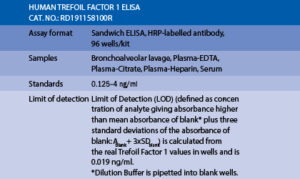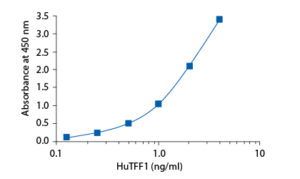Trefoil Factor 1 Human ELISA
Trefoil factor 1 (TFF1, pS2) is a small secreted protein with molecular weight of 6.5 kDa (monomers, 14 kDa – dimers). It belongs to the TFF protein family that is characterized by a clover leaf–like disulphide structure named the TFF domain, which is created by 6 cysteines forming three intramolecular bonds. TFF1 contains one trefoil domain, but has a seventh cysteine in position 57 that is essential for formation of dimers. TFF1 exist as both monomers and dimers (homo- and heterodimers – with gastrokine 2). The most abundant expression of TFF1 is found in the GI tract (especially in stomach, colon and pancreas) where it is co-localised with mucins, usually with MUC5AC. It is probable that TFF1 is closely connected with healing and stabilisation of the mucin layer. TFF1 was found in significant amounts in ulcer associated cell lineage UACL, where EGF (epidermal growth factor) is also present. The hypothesis that TFF1 expression is influenced by EGF has been proposed, and this has been supported by a study on EGF KO mice which had lower levels of TFF1. A study examining people with Crohn´s disease and inflammatory bowel disease showed that TFF1 level in serum is increased during the inflammatory state. TFF1 is also highly expressed in the trachea and its level increases after administration of allergen, indicating thatTFF1 could be associated with asthma. Another study found that TFF1 levels are high in septic patients and that the level correlates with prognosis of the septic state. High levels of TFF1 in serum were also found in patients with prostate and other types of cancer (breast, colon and ovarian tumors) but its prognostic value has not yet been proved. The exact function of TFF1 is not yet fully understood.
The RD191158100R Human Trefoil Factor 1 ELISA is a sandwich enzyme immunoassay for the quantitative measurement of human Trefoil Factor 1.
In the BioVendor Human Trefoil Factor 1 ELISA, standards and samples are incubated in microtitrate plate wells pre-coated with polyclonal anti-human Trefoil Factor 1 antibody. After 60 minutes incubation and washing, polyclonal anti-human Trefoil Factor 1 antibody, conjugated with horseradish peroxidase (HRP) is added to the wells and incubated for 60 minutes with captured Trefoil Factor 1. Following another washing step, the remaining HRP conjugate is allowed to react with the substrate solution (TMB). The reaction is stopped by addition of acidic solution and absorbance of the resulting yellow product is measured. The absorbance is proportional to the concentration of Trefoil Factor 1. A standard curve is constructed by plotting absorbance values against concentrations of Trefoil Factor 1 standards, and concentrations of unknown samples are determined using this standard curve.
Intended use
Clinical Application
Test principle


Summary of protocol
– Zurek J, Fedora M. Trefoil Factor 1 as a marker of mucosal damage of the gastrointestinal tract in children with sepsis. Biomarkers. 2013 Apr 29;

